$PQVERNO,LC79DANR01A07S,2022/03/24,16:44:51*65
1. USB-connected virtual serial ports support two serial ports: "Enhanced COM port" and "Standard COM port"
2. GPS commands are valid only for Enhanced COM ports
Enhanced COM port can be checked in "Ports (COM & LPT)" in Device Manager.
Commands such as NMEA output cycle change are not reflected until commands such as Hot Start are executed after that.
3. If the communication speed of the serial port is changed to other than 57600bps, the Bluetooth SPP connection cannot be used.
4. There are only two types of positioning status for NMEA sentences: "Invalid" and "SPS fix" (DGPS etc. are not output)
5. Allocation of "Msg total" and "Msg num" in GSV sentence is different from u-blox ZED-F9P
u-blox ZED-F9P separates "Msg total" by SignalID, but P-7 Pro displays it all together.
$Msg ID,Msg total,Msg num, ... ,Signal ID*sum
P-7 Pro
$GAGSV,4,1, ... ,6*75 (L1-A)
$GAGSV,4,2, ... ,6*7A (L1-A)
$GAGSV,4,3, ... ,1*73 (E5a)
$GAGSV,4,4, ... ,1*7B (E5a)
ZED-F9P
$GAGSV,3,1, ... ,2*7D (E5b)
$GAGSV,3,2, ... ,2*7D (E5b)
$GAGSV,3,3, ... ,2*7B (E5b)
$GAGSV,2,1, ... ,7*72 (L1-BC)
$GAGSV,2,2, ... ,7*44 (L1-BC)
6. PRN number of NMEA sentence is different from u-blox ZED-F9P
Galileo is +100 and BeiDou is +200 against the u-blox ZED-F9P PRN.
7. The number of satellites reported by GLONASS and BeiDou in the GSV sentence is small.
NMEA sample
$GNRMC,035100.00,A,3521.056771,N,13923.388304,E,6.7,88.8,080523,,,A,V*01
$GNGGA,035100.00,3521.056771,N,13923.388304,E,1,17,1.2,8.0,M,39.0,M,,*7B
$GNGLL,3521.056771,N,13923.388304,E,035100.00,A,A*79
$GPGSV,4,1,12,01,74,354,42,03,41,162,45,07,14,216,38,08,35,088,47,1*67
$GPGSV,4,2,12,14,49,306,26,27,05,099,28,30,21,249,41,1*58
$GPGSV,4,3,12,01,74,354,42,03,41,162,45,08,35,088,46,27,05,099,27,8*64
$GPGSV,4,4,12,30,21,249,46,8*53
$GLGSV,1,1,01,87,48,305,25,1*4B
$GAGSV,2,1,08,112,30,248,35,121,04,150,25,131,64,291,43,133,74,317,45,6*7F
$GAGSV,2,2,08,112,30,248,37,121,04,150,25,131,64,291,45,133,74,317,44,1*7E
$GBGSV,2,1,05,207,65,311,37,209,08,236,26,211,45,050,24,223,44,235,45,1*77
$GBGSV,2,2,05,225,18,185,38,1*78
$GQGSV,2,1,06,02,68,190,45,03,86,309,45,07,47,201,38,1*5F
$GQGSV,2,2,06,02,68,190,44,03,86,309,44,07,47,201,43,8*59
$GNGSA,A,3,01,03,07,08,14,30,,,,,,,2.0,1.2,1.7,1*3D
$GNGSA,A,3,87,,,,,,,,,,,,2.0,1.2,1.7,2*3A
$GNGSA,A,3,112,131,133,,,,,,,,,,2.0,1.2,1.7,3*04
$GNGSA,A,3,207,211,223,225,,,,,,,,,2.0,1.2,1.7,4*32
$GNGSA,A,3,02,03,07,,,,,,,,,,2.0,1.2,1.7,5*34
$GNVTG,88.8,T,,M,6.7,N,12.4,K,A*1D
8. Resolution of altitude is in 1-meter increments (The digit of 0.1 m is always zero).
9. Comparison between P-7 Pro and NEO-M8U, ZED-F9P(SLAS): 24-hour observation data
|
2drms(Horizontal) |
2drms(Vertical) |
Mean error (horizontal) |
Mean error (vertical) |
| P-7 Pro |
3.14m |
4.69m |
1.55m |
2.01m |
| NEO-M8U |
2.30m |
3.27m |
0.51m |
-0.16m |
| ZED-F9P (SLAS) |
1.76m |
3.35m |
0.14m |
1.03m |
* P-7 Pro is CEP(50%) = 3.14m*0.416273762 ≒ 1.31m
* P-7 Pro is not performing to specifications (At least in the Japan region).
Note) 2drms was obtained using a calculation formula, so if the variance deviates from a normal distribution, an error will occur.
The actual values obtained by counting the measured values are as follows.
| P-7 Pro |
Horizontal |
Vertical |
| CEP(98.17%) |
3.64m |
6.9m |
| 2drms(95.45%) |
3.06m |
6.2m |
| CEP(95%) |
3.02m |
6.2m |
| CEP(90%) |
2.55m |
5.2m |
| CEP(50%) |
1.21m |
2.2m |
P-7 Pro error graph (24-hour observation: average value basis)
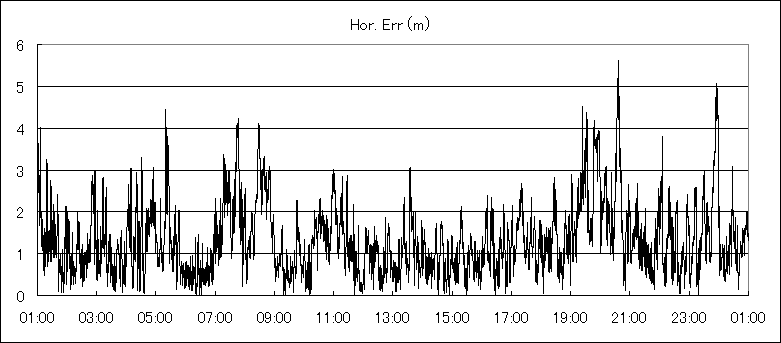

P-7 Pro XY trajectory plot (24-hour observation: average value basis)

NEO-M8U error graph (24-hour observation: average value basis)
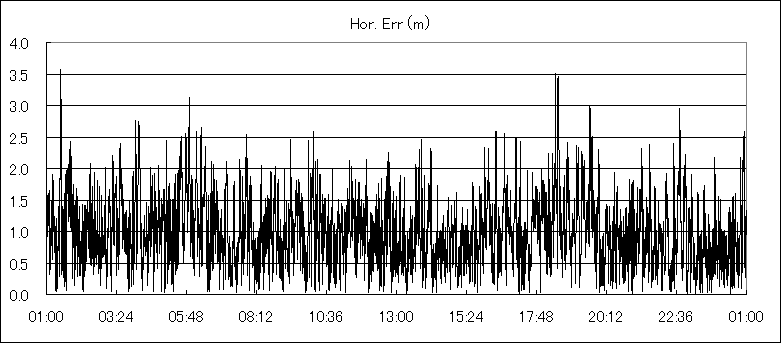
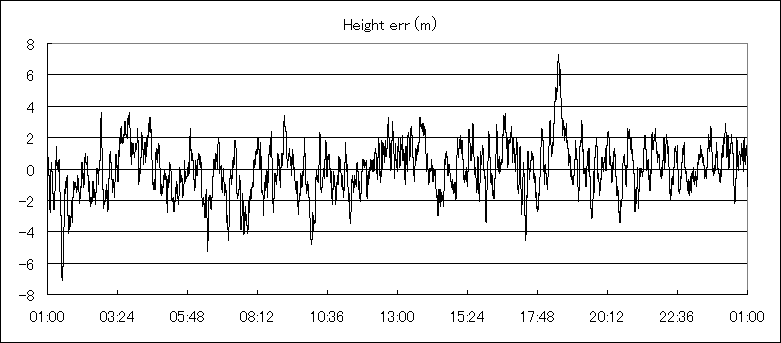
NEO-M8U XY trajectory plot (24-hour observation: average value basis)
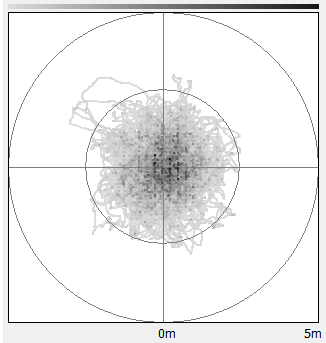
ZED-F9P(SLAS) error graph (24-hour observation: average value basis)

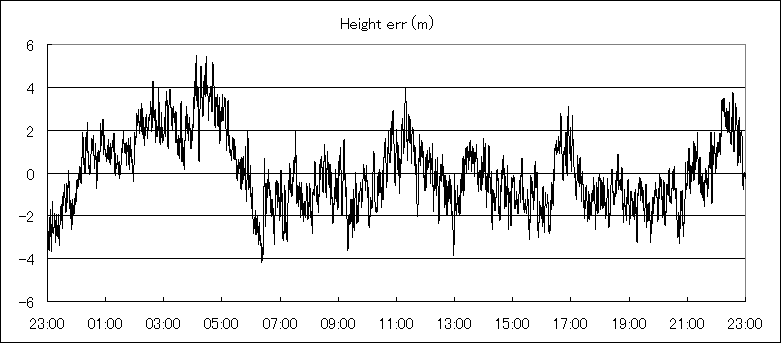
ZED-F9P(SLAS) XY trajectory plot (24-hour observation: average value basis)
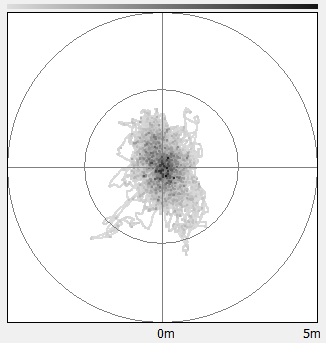
Note) SLAS is valid only in the Japan region.
10. Current Consumption
About 69 to 113mA (including accessories antenna ANT-DF1).
11. Comparison of trajectories in urban areas
The antenna was a BT-345AJ (Beitian) with a splitter for branching (Antenna position is above the head).
1) P-7 Pro vs NEO-M8U

2) P-7 Pro vs ZED-F9P
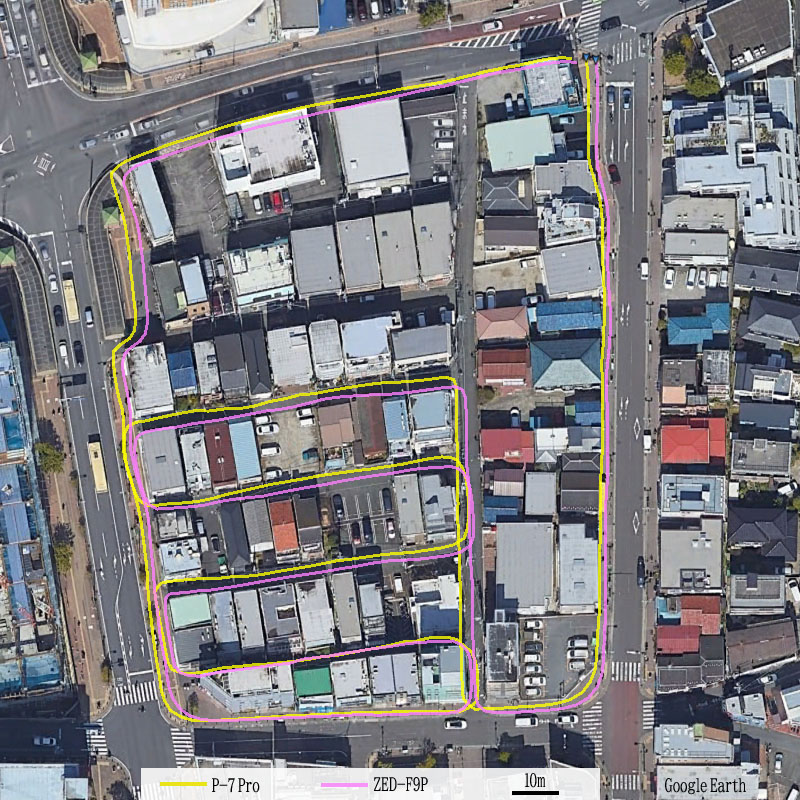
12. Impressions after using
The multi-path support provides a clean track even in urban areas.
Absolute position accuracy in open sky is not much different from single-frequency GPS.
13. Resource Link
PDF: LC79D (A) GNSS Protocol Specification
Additional description
According to How to test the P-7 Pro's positioning accuracy the observation time is set to 1 hour or longer,
and the example figure also shows CEP(50%)=0.455185m after 1 hour of observation.
However, to obtain GPS accuracy, 24 hours of observation is required (Sidereal day=23:56:04.0905 to be exact).
The example of convergence of 2drm
|